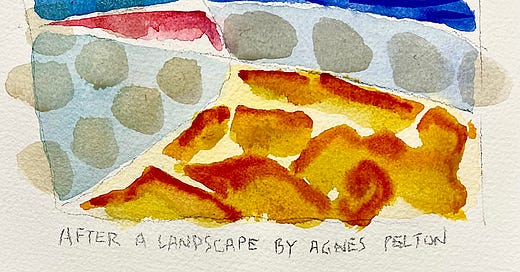The MAGA attack on Chicago as a "hell hole" doesn't hold up.
While many are still victims of great economic inequality, Chicago's is the economic driver for the state.
My drawings and watercolors on Instagram @klonskyart
MAGA candidate for Illinois governor, Darren Bailey, has made Chicago the boogyman in his campaign to unseat Democrat JB Pritzker.
Echoing Trump who called Haiti and African nations, “shit hole countries,” Bailey describes Chicago as a “hell hole”.
Bailey’s TV ads are aimed at scaring the bejesus out of downstate white folks featuring Mayor Lori Lightfoot with dark bags under her eyes.
While for too many, the daily struggle and the gross inequalities of income between the state and city’s wealthiest and its working class are all too glaring, a report from the Illinois Economic Policy Institute paints a very different picture of Illinois and Chicago than that painted by Ken Griffin, Darren Bailey, McDonald’s CEO Chris Kempczinski, Dan Proft and the Illinois Policy Institute.
These billionaires’ use of Chicago as their whipping boy seems to me calculated to win tax breaks, oppose unions and a living wage and, as I say, to scare downstate white folks into voting for their racist MAGA candidates
The attack on Chicago is not for the purpose of addressing the real needs of working people, of which there are many.
According to the IEPI, if metropolitan Chicago were its own state, its 3.7% annualized growth between 2010 and 2019 would rank 21st in the nation. That's tied with Ohio and ahead of states like Iowa, Michigan and Indiana.
Illinois’ GDP out performs every other Midwestern state.
The IEPI reports does show that equal economic growth is not happening statewide.
Economic stagnation outside of the Chicago area is the primary reason why Illinois has grown much slower than the national average. Between 2010 and 2019, the U.S. economy expanded by 42 percent, an annualized rate of 4.0 percent. Illinois only grew by 34 percent, an annualized rate of 3.3 percent.
Most of the Chicago area grew at a rate similar to, but slightly below, the national average. Kane County and Kendall County grew by 3.9 percent annualized, DuPage County by 3.8 percent annualized, and Cook County by 3.7 percent annualized. Will County grew faster than the national average, experiencing a 53 percent cumulative increase in its GDP or a growth of 4.8 percent annualized. The 2.1 percent growth rate of Downstate Illinois, on the other hand, was half the national average.
In 2019, lawmakers in the General Assembly introduced a facetious resolution calling for the separation of the Chicago area and Downstate Illinois into two different states (Sullender, 2021; Miller, 2020).
Between 2010 and 2019, Illinois’ 34 percent gain in nominal economic activity ranked 31st in the United States. If the Chicago area were its own state, its total growth of over 38 percent would have made it the 21st-fastest growing economy in the nation over this time. The Chicago area grew faster than neighboring Iowa (37 percent), Indiana (35 percent), Wisconsin (34 percent), Kentucky (30 percent), and Missouri (28 percent).
By contrast, if Downstate Illinois was separated out, its total growth of 21 percent would have ranked 46th nationally, ahead of only New Mexico (21 percent), West Virginia (20 percent), Louisiana (13 percent), Wyoming (5 percent), and Alaska (2 percent).
So for most working families in Chicago and downstate life can be a constant struggle.
But the Bailey/Griffin/IPI narrative of Chicago as a “hell hole” doesn’t hold up when we look at the facts.




